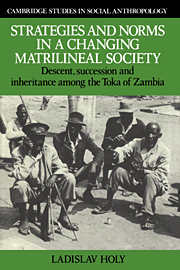 Strategies and Norms in a Changing Matrilineal Society
Strategies and Norms in a Changing Matrilineal Society Book contents
- Frontmatter
- Contents
- List of maps and diagrams
- List of tables
- Acknowledgements
- Introduction
- 1 Descent categories and local ties in traditional Toka society
- 2 Technological development and the restructuring of the relations of production
- 3 Changing norms of inheritance
- 4 The structure of local groups
- 5 The changing concept of the basimukowa
- 6 Mukowa and ritual
- 7 The role of the mukowa in succession
- 8 The role of the mukowa in inheritance
- 9 Mukowa: representational and operational models
- 10 Norms as a strategic resource
- Appendix 1 Village fission in Guta
- Appendix 2 Aspects of individual mobility in Ngwezi
- Notes
- References
- Index
- Cambridge Studies in Social Anthropology
- Frontmatter
- Contents
- List of maps and diagrams
- List of tables
- Acknowledgements
- Introduction
- 1 Descent categories and local ties in traditional Toka society
- 2 Technological development and the restructuring of the relations of production
- 3 Changing norms of inheritance
- 4 The structure of local groups
- 5 The changing concept of the basimukowa
- 6 Mukowa and ritual
- 7 The role of the mukowa in succession
- 8 The role of the mukowa in inheritance
- 9 Mukowa: representational and operational models
- 10 Norms as a strategic resource
- Appendix 1 Village fission in Guta
- Appendix 2 Aspects of individual mobility in Ngwezi
- Notes
- References
- Index
- Cambridge Studies in Social Anthropology
Summary
In spite of the frequent fission of villages and the perpetual emergence of new hamlets, it is not unusual for a large hamlet to be inhabited by members of a mukowa three or four generations deep. The core of the inhabitants of the headman's hamlet in Mujalanyana (Diagram 11) consists of cognatic descendants of Cabakani (M2) who consider themselves to be members of his mukowa, Cabakani (M2) being an ancestor three generations removed from the youngest adult generation of the inhabitants of the hamlet. Equally, with the exception of Godfrey, the inhabitants of Kawayo's hamlet in Mujalanyana (Diagram 11) are all cognatic descendants of Mukakongo (M5) and they all consider themselves to be members of the mukowa of which she is the apical ancestress. Mukakongo (M5) is again three generations removed from the youngest adult generation of the inhabitants of the hamlet. Most of the inhabitants of the headman's hamlet in Mujala Mupati (Diagram 10) are cognatic descendants of Munkombwe (L1) and consider themselves to be members of the mukowa of which she is the apical ancestress; Munkombwe (L1) is four generations removed from the youngest adult generation of the inhabitants of the hamlet.
It has been mentioned in Chapter 4 that hamlet boundaries represent important and significant cleavages in the field of social interaction and everyday face-to-face contact between individuals. In spite of this, the boundaries of recognised mukowa categories do not coincide with hamlet boundaries.
- Type
- Chapter
- Information
- Strategies and Norms in a Changing Matrilineal SocietyDescent, Succession and Inheritance among the Toka of Zambia, pp. 131 - 148Publisher: Cambridge University PressPrint publication year: 1986
